Appliances
Optimal Ceiling Fan Wattage Rating Explained
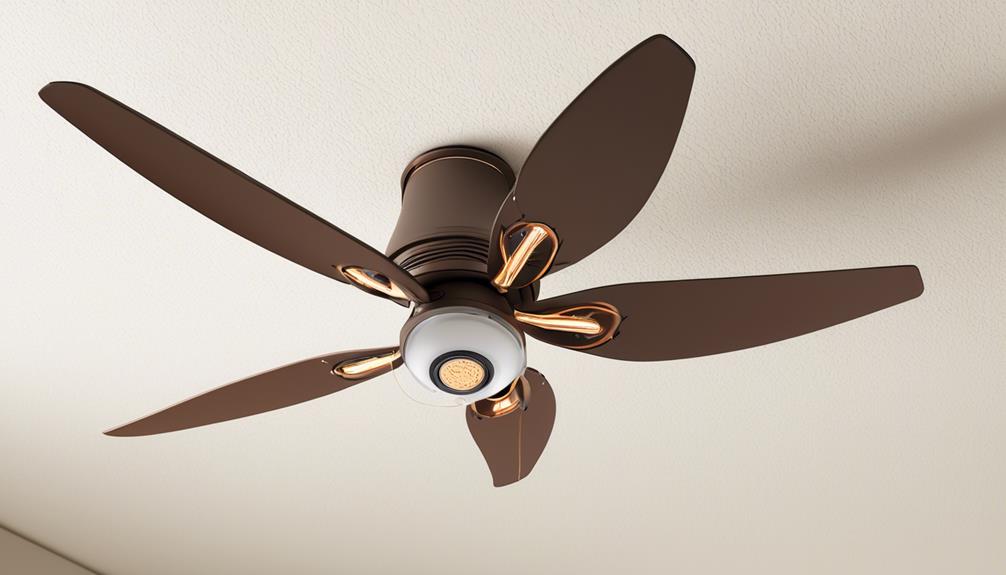
Interested in learning about how much energy ceiling fans use? Get ready, because we’re going to explore the realm of ceiling fan power usage!
Understanding the wattage rating of a ceiling fan is crucial for ensuring optimal performance and energy efficiency. It helps us determine the appropriate amount of power needed to operate the fan effectively.
In this article, we will explore the factors that affect a ceiling fan’s wattage, the typical wattage range, and how to find the wattage rating of your fan. We’ll also provide some recommendations on wattage for different uses and offer tips to maximize efficiency and safety.
So, let’s get started and shed some light on the wattage of ceiling fans!
Key Takeaways
- Comparing the wattage of different ceiling fans helps in making informed decisions about energy efficiency.
- Opt for ceiling fans with lower wattage motors to save energy.
- Choose fans with LED light kits, as they are more energy-efficient.
- Understanding the wattage rating is crucial for maximizing energy savings and reducing utility bills.
Understanding Ceiling Fan Wattage
Understanding ceiling fan wattage is crucial when determining the energy efficiency and power consumption of a fan. Ceiling fan wattage refers to the amount of electrical power the fan consumes. By comparing the wattage of different ceiling fans, you can make an informed decision about which fan is more energy-efficient.
When comparing ceiling fan wattage, it’s important to consider both the fan’s motor wattage and the wattage of its light kit, if applicable. The motor wattage represents the power required to operate the fan’s motor, while the light kit wattage refers to the power consumed by the fan’s built-in lighting.
To save energy and reduce power consumption, consider the following tips. Firstly, opt for ceiling fans with lower wattage motors, as they’ll consume less electricity. Additionally, choose fans with LED light kits, as they’re more energy-efficient than traditional incandescent bulbs. Lastly, consider using a fan without a light kit altogether if you don’t require overhead lighting in the room.
Understanding ceiling fan wattage allows you to make informed decisions when it comes to energy efficiency and power consumption. By comparing wattages and implementing energy-saving tips, you can enjoy the benefits of a comfortable and efficient cooling system while reducing your energy consumption and saving on utility bills.
Importance of Knowing the Wattage Rating

Knowing the wattage rating of a ceiling fan is crucial for several reasons.
Firstly, understanding the wattage rating allows homeowners to determine the amount of energy the fan consumes, helping them make informed decisions about energy efficiency and cost savings.
Additionally, knowing the wattage rating enables users to ensure that the fan is compatible with their electrical system, preventing any potential electrical hazards.
Lastly, being aware of the wattage rating allows homeowners to compare different fan models and choose the one that best meets their energy needs and preferences.
Wattage Rating Explanation
Create an image depicting a ceiling fan with a wattage rating label clearly visible, surrounded by various household appliances showcasing their wattage labels.

The wattage rating of a ceiling fan is a crucial piece of information that allows users to understand the amount of power the fan consumes. Understanding energy consumption is essential for maximizing energy savings and reducing utility bills.
The wattage rating of a ceiling fan indicates the power consumption of the fan motor and any built-in lighting fixtures. By knowing the wattage rating, users can calculate the energy usage and estimate the cost of running the fan. This information enables users to make informed decisions about energy-efficient options and potentially reduce their carbon footprint.
Additionally, understanding the wattage rating helps users avoid overloading circuits and ensures the longevity of the fan. By considering the wattage rating, users can optimize their energy usage and make environmentally conscious choices.
Energy Efficiency Insights
Create an image showcasing a ceiling fan with a clear view of its wattage rating label, emphasizing the importance of knowing the wattage for energy efficiency insights.
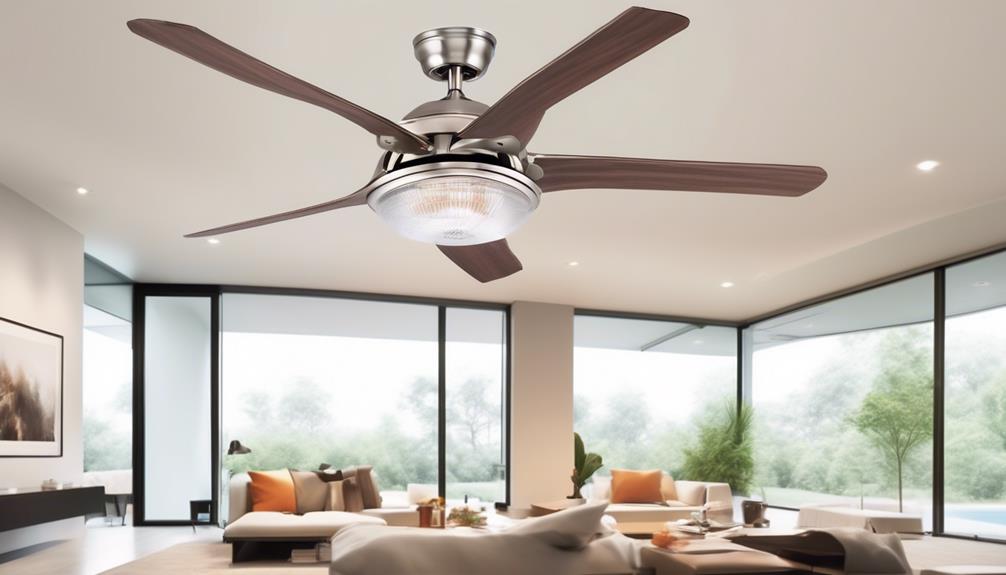
To fully harness the benefits of energy efficiency and ensure optimal power usage, it’s pivotal to take into account the wattage rating of a ceiling fan.
Understanding the wattage rating allows us to make informed decisions when choosing a fan and implementing energy saving tips. By selecting a ceiling fan with a lower wattage rating, we can significantly reduce energy consumption and save on electricity bills.
Additionally, knowing the wattage rating helps us determine the fan’s efficiency in converting electrical energy into mechanical airflow. This knowledge empowers us to choose a fan that can effectively cool or circulate air while minimizing power usage.
Ultimately, understanding the wattage rating of a ceiling fan is an essential aspect of maximizing energy efficiency and reaping the numerous benefits it brings.
Factors Affecting Ceiling Fan Wattage
Understanding the various factors that can impact ceiling fan wattage is crucial for selecting the most energy-efficient option for your needs. When considering the wattage requirements for different room sizes, it’s important to take into account the following factors:
- Ceiling Fan Size: The size of the fan blades can affect the amount of energy the fan consumes. Larger fan blades may require more wattage to operate efficiently.
- Motor Efficiency: The efficiency of the fan’s motor plays a significant role in determining the wattage consumption. High-quality motors are designed to operate more efficiently, resulting in lower wattage usage.
- Speed Settings: The wattage consumption of a ceiling fan can vary depending on the speed setting. Higher speeds generally require more energy, while lower speeds consume less wattage.
- Lighting Options: If your ceiling fan includes built-in lighting, the wattage consumption will increase. Consider energy-efficient lighting options, such as LED bulbs, to minimize energy usage.
- Room Size and Ceiling Height: The size of the room and the height of the ceiling can impact the wattage requirements of a ceiling fan. Larger rooms may require fans with higher wattages to provide sufficient airflow, while higher ceilings may require fans with more powerful motors to circulate air effectively.
Exploring the Typical Wattage Range

Now let’s explore the typical wattage range of ceiling fans.
Understanding the wattage range is important because it helps determine the power requirements for fans.
Wattage Range Explained
Create an image showcasing a diverse selection of ceiling fans, each emitting a different intensity of light, to visually explain the wattage range of ceiling fans.
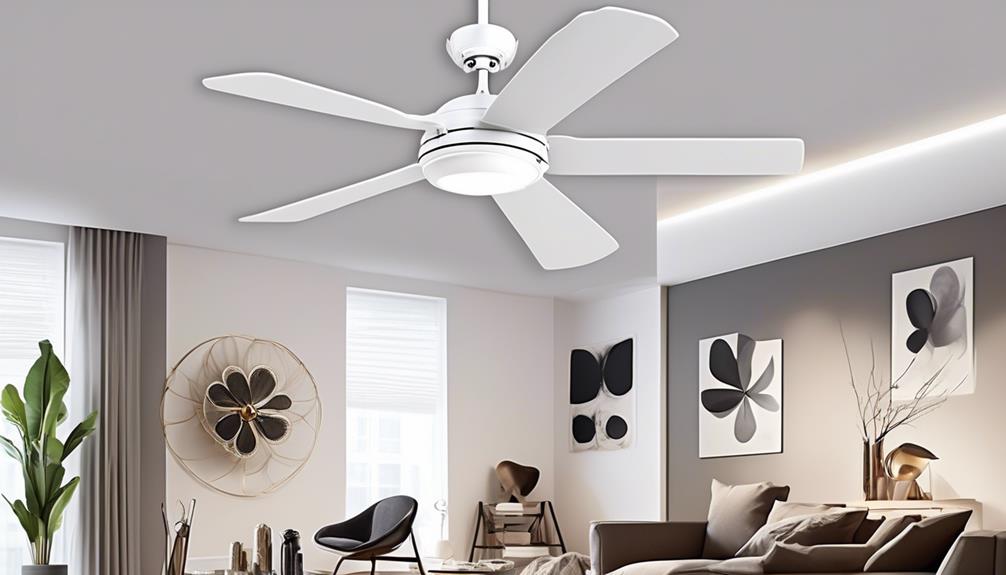
The wattage range of ceiling fans can vary depending on various factors such as the size, motor power, and additional features. Understanding wattage limits and selecting the appropriate wattage for your ceiling fan is crucial for optimal performance and energy efficiency. Here are some key points to consider:
- Size of the ceiling fan: Larger fans generally require higher wattage to operate effectively.
- Motor power: Fans with more powerful motors may have higher wattage requirements.
- Additional features: Fans with built-in lights, remote controls, or other features may have higher wattage needs.
When selecting a ceiling fan, it’s important to check the wattage rating provided by the manufacturer. This information can typically be found in the product specifications or user manual.
Power Requirements for Fans
Create an image showcasing a diverse range of ceiling fans, each emitting a soft glow. Varying wattages are represented through vibrant color gradients, visually highlighting the power requirements and typical wattage range for fans.

To accurately assess the power requirements for ceiling fans, it is crucial to take into account various factors such as the size, motor power, and additional features, which collectively contribute to the typical wattage range. Understanding energy consumption and calculating power usage are key to determining the appropriate wattage for a ceiling fan.
To provide a comprehensive overview, let’s examine the typical wattage range for ceiling fans in the table below:
Ceiling Fan Size Motor Power (Watts) Small 20-50 Medium 50-75 Large 75-100
This table showcases the estimated wattage range for different ceiling fan sizes. It is important to note that additional features like lighting fixtures, remote controls, or variable speed settings may increase the wattage. By understanding these energy consumption factors and calculating the power usage, you can make an informed decision when selecting a ceiling fan that aligns with your specific needs and preferences.
Selecting the Right Wattage for Your Room Size

Selecting the appropriate wattage for your room size is crucial to ensure optimal performance and energy efficiency of your ceiling fan. Understanding efficiency levels and selecting appropriate lighting are key factors in determining the right wattage for your ceiling fan.
Here are some important considerations to keep in mind:
- Room size: The size of your room plays a significant role in determining the wattage you need. Larger rooms require more wattage to effectively circulate air and provide sufficient lighting. On the other hand, smaller rooms may require lower wattage for efficient operation.
- Ceiling height: The height of your ceiling also affects the wattage requirements. Higher ceilings may necessitate more powerful fans to effectively distribute air throughout the room.
- Additional lighting: If you plan on using your ceiling fan as the primary source of lighting in the room, it’s essential to choose a fan with higher wattage to provide adequate brightness.
- Energy efficiency: Opt for ceiling fans with energy-efficient motors and LED lighting options to minimize energy consumption and reduce utility bills.
- Personal preference: Consider your personal preferences and the specific needs of your space when selecting the wattage for your ceiling fan. Some individuals may prefer brighter lighting, while others may prioritize energy efficiency.
Energy Efficiency and Wattage
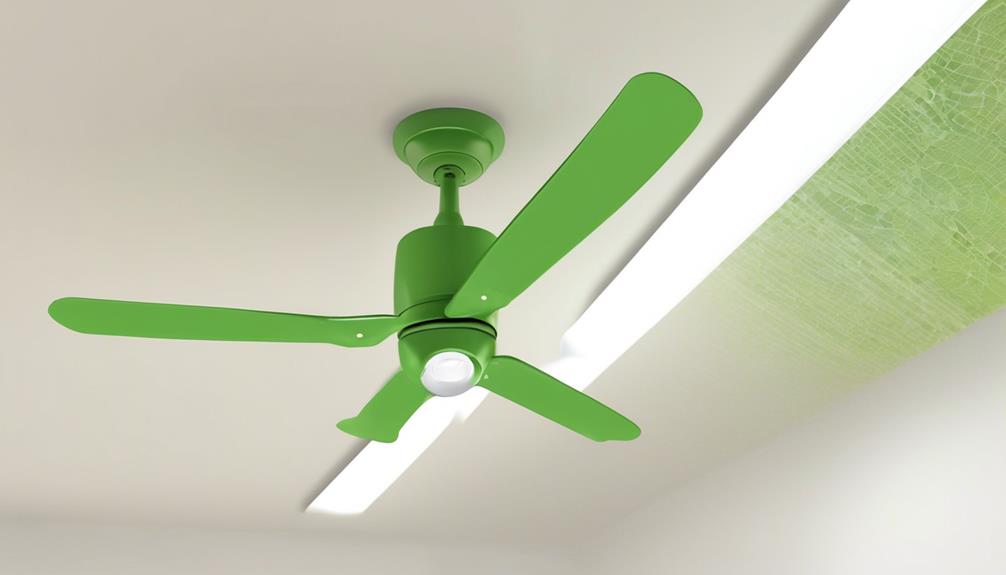
When it comes to energy efficiency and wattage, there are a couple of important points to consider.
First, it’s useful to compare the power consumption of different ceiling fans to determine which ones are more energy-efficient.
Additionally, many ceiling fans come with energy-saving features like adjustable speed settings and LED lights, which can further reduce energy consumption.
Power Consumption Comparison
Create an image that showcases two ceiling fans side by side, one labeled with a high wattage and the other with a low wattage, emphasizing the difference in power consumption and energy efficiency.
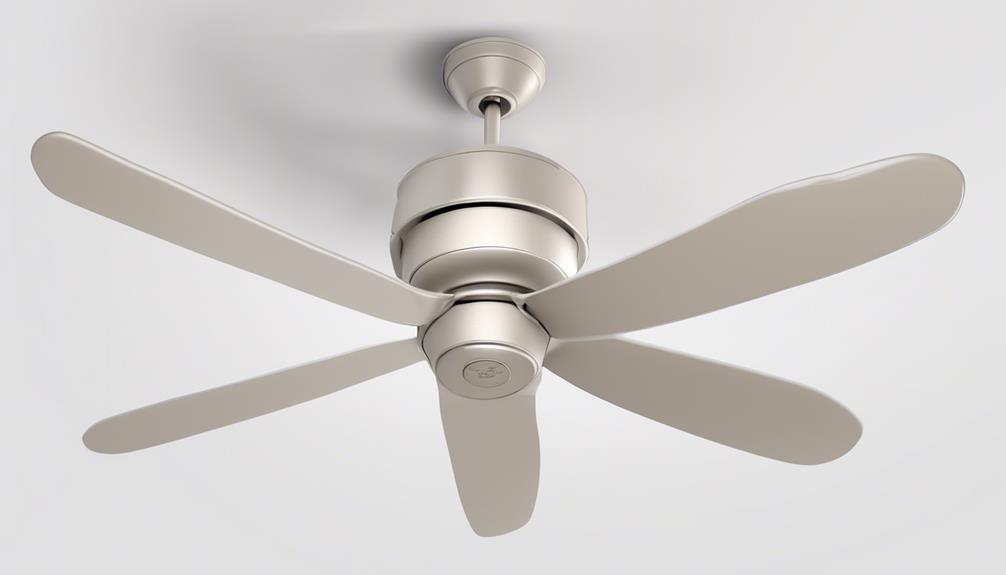
In comparing power consumption, it’s important to consider the energy efficiency and wattage of ceiling fans. Ceiling fans are designed to provide comfort while minimizing energy usage and costs.
When comparing the power consumption of different ceiling fans, there are several factors to consider:
- Energy Efficiency: Ceiling fans with higher energy efficiency ratings consume less electricity while delivering the same level of airflow.
- Wattage: The wattage of a ceiling fan indicates the amount of power it consumes. Lower wattage fans are more energy-efficient and cost-effective to run.
- Blade Design: The design of the blades can affect the airflow and energy consumption of a ceiling fan. Fans with well-designed blades can move air efficiently, reducing power consumption.
- Motor Efficiency: High-efficiency motors convert electrical energy into mechanical energy more effectively, resulting in lower power consumption.
- Speed Settings: Ceiling fans with multiple speed settings allow users to adjust the airflow according to their needs, helping to conserve energy when maximum airflow isn’t required.
Energy-Saving Features Explanation
Create an image showing the inner workings of a ceiling fan, prominently displaying energy-saving features like LED lights and a DC motor, emphasizing wattage and energy efficiency.
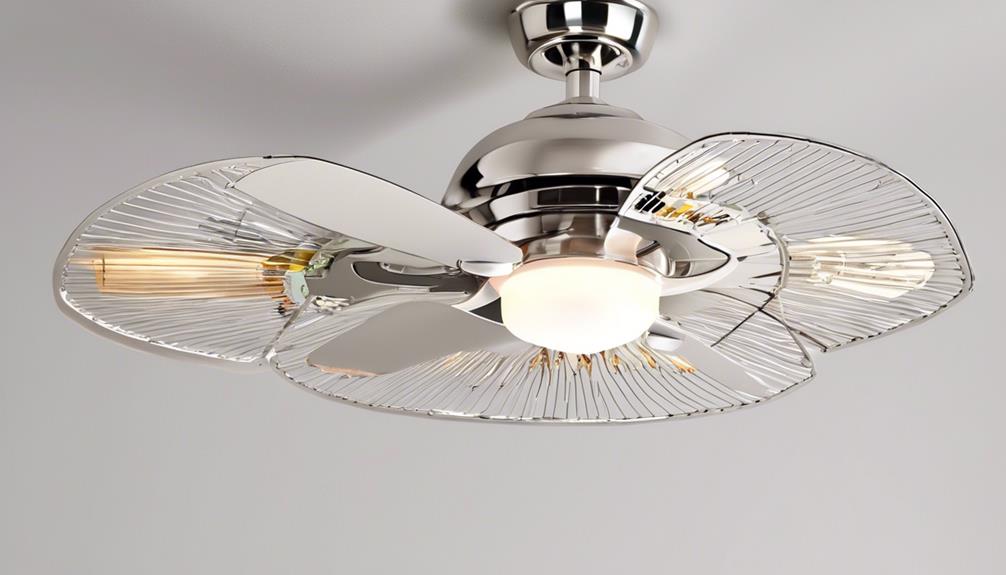
To further explore the energy-saving features of ceiling fans, let’s now examine the importance of energy efficiency and wattage in relation to their power consumption.
Energy-saving features are designed to reduce the amount of electricity consumed by a ceiling fan, resulting in lower energy bills and less strain on the environment. One such feature is the use of energy-efficient motors that require less power to operate, while still providing optimal performance.
Additionally, the design of the fan blades can contribute to energy conservation techniques. For example, fans with aerodynamically designed blades can move air more efficiently, requiring less power to achieve the same airflow.
It’s important to pay attention to the wattage rating of a ceiling fan to ensure that it aligns with your energy-saving goals. By selecting a fan with a lower wattage, you can maximize energy efficiency and reduce your carbon footprint.
Can You Use a Higher Wattage Bulb?

Using a higher wattage bulb in a ceiling fan can result in potential safety hazards and damage to the fan’s electrical components. It’s important to follow the manufacturer’s guidelines and not exceed the recommended wattage for the bulb. Here are some reasons why using a higher wattage bulb isn’t recommended:
- Safety hazards: Exceeding the recommended wattage can lead to overheating, which increases the risk of fire. It can also cause the bulb to shatter, posing a potential risk of injury.
- Electrical damage: Ceiling fans are designed to handle specific wattages, and using a higher wattage bulb can overload the electrical components. This can lead to damage such as blown fuses, tripped circuit breakers, or even permanent damage to the fan’s motor.
- Reduced lifespan: Higher wattage bulbs generate more heat, which can shorten the lifespan of both the bulb and the fan’s electrical components. This can result in frequent replacements and costly repairs.
- Diminished energy efficiency: Ceiling fans are often used for their energy-saving benefits. Using a higher wattage bulb can increase energy consumption and negate the energy-saving advantages of the fan.
- Alternative lighting options: Instead of using a higher wattage bulb, consider alternative lighting options such as LED bulbs or CFLs. These bulbs provide bright light while consuming less energy and generating less heat, making them a safer and more energy-efficient choice for ceiling fans.
Common Wattage Ratings for Ceiling Fans
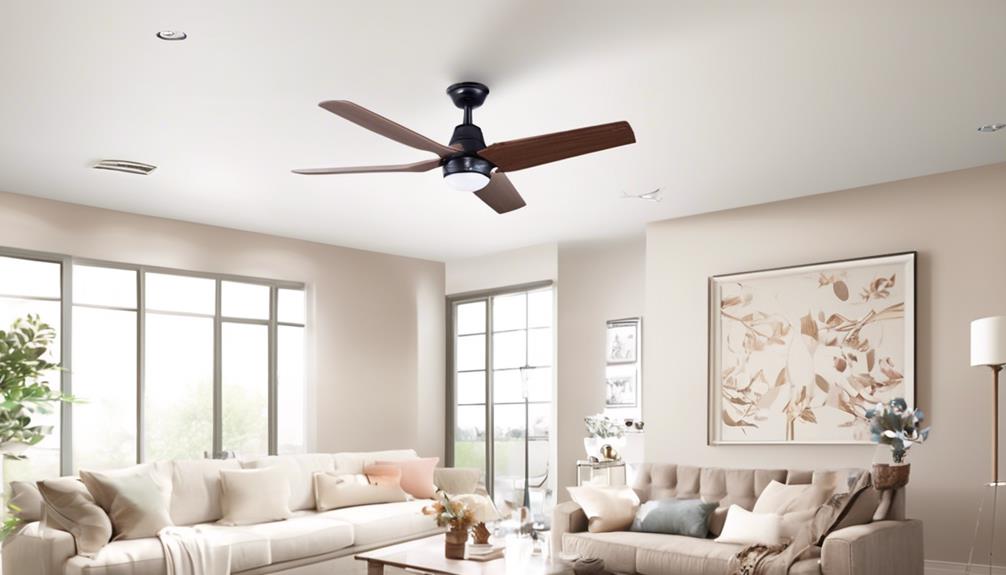
After understanding the potential hazards of using a higher wattage bulb in a ceiling fan, it is important to explore the common wattage ratings for these fans. By knowing the wattage rating of a ceiling fan, you can ensure that you choose the right fan for your needs and prevent any electrical issues.
Ceiling fans typically have wattage ratings ranging from 10 to 120 watts. The actual wattage rating depends on various factors such as the size of the fan, the number of blades, and the motor efficiency. To give you a better idea, here’s a table showcasing the common wattage ratings for ceiling fans:
Ceiling Fan Size Number of Blades Wattage Rating 36 inches 3 10-30 42 inches 4 40-60 52 inches 5 60-100 60 inches 6 100-120 72 inches 8 120-150
When choosing a ceiling fan, consider energy-saving tips such as opting for fans with lower wattage ratings. This will not only help you save on energy costs but also reduce your carbon footprint. Additionally, ensure that the wattage rating of the fan matches the wattage capacity of your electrical circuit to avoid any potential electrical hazards.
How to Find the Wattage Rating of Your Ceiling Fan

To determine the wattage rating of your ceiling fan, you can refer to the product manual or inspect the labeling on the fan itself. These sources will typically provide you with the necessary information to understand the power consumption of your ceiling fan. Here are some steps you can follow to find the wattage rating:
- Product Manual: The product manual is often the most reliable source for finding wattage specifications. It will usually include a section that outlines the electrical requirements of the fan, including the wattage rating. Look for information regarding power consumption or electrical specifications.
- Labeling on the Fan: The fan itself may have a label that displays the wattage rating. This label is usually located on the motor housing or on the fan’s control panel. Look for any markings or stickers that provide electrical information, including the wattage rating.
- Manufacturer’s Website: If you don’t have access to the product manual or can’t find the wattage rating on the fan, you can visit the manufacturer’s website. Most manufacturers provide product information and specifications online, including wattage ratings for their ceiling fans.
- Customer Support: If you’re still unable to find the wattage rating, you can contact the manufacturer’s customer support. They should be able to provide you with the necessary information or guide you in finding it.
- Professional Electrician: If all else fails, you can consult a professional electrician. They have the expertise to calculate the energy consumption of your ceiling fan accurately.
The Relationship Between Wattage and Fan Speed

When determining the wattage rating of your ceiling fan, it is important to understand the relationship between wattage and fan speed. Fan speed control plays a crucial role in managing the energy consumption of your ceiling fan. By adjusting the fan speed, you can optimize its performance while minimizing energy usage. An energy consumption analysis can help you determine the ideal wattage for your ceiling fan based on your desired fan speed.
To illustrate the relationship between wattage and fan speed, consider the following table:
Fan Speed (RPM) Wattage (W) Low 20 Medium 40 High 60 Turbo 80
In this table, we can see that as the fan speed increases, the wattage also increases. This is because higher fan speeds require more power to rotate the blades at a faster rate. Conversely, lower fan speeds consume less energy.
Wattage Recommendations for Different Ceiling Fan Uses

Our recommended wattage for different ceiling fan uses is based on a comprehensive analysis of energy efficiency and performance. We’ve conducted a thorough power consumption analysis to determine the appropriate wattage recommendations for various ceiling fan applications. Here are our findings:
- General Air Circulation: For regular air circulation in a room, a ceiling fan typically consumes around 15-50 watts of power. This range ensures efficient airflow without unnecessarily increasing energy consumption.
- Cooling: When using a ceiling fan for cooling purposes, we recommend a wattage range of 40-90 watts. This higher wattage allows the fan to operate at a higher speed, providing a cooling breeze during hot summer months.
- Heating: In reverse mode, a ceiling fan can help distribute warm air evenly throughout the room. For this purpose, a wattage range of 10-25 watts is sufficient to gently circulate the warm air without creating a cooling effect.
- Lighting: Ceiling fans with built-in light fixtures require additional power for lighting. The recommended wattage for ceiling fans with lights ranges from 60-150 watts, depending on the desired brightness level.
- Energy Efficiency: If energy efficiency is a top priority, we recommend choosing ceiling fans with lower wattage ratings. Opting for models in the lower end of the wattage range for each application can help reduce energy consumption while maintaining optimal performance.
Tips for Maximizing Efficiency and Safety

After understanding the wattage recommendations for different ceiling fan uses, it’s important to consider tips for maximizing efficiency and safety.
To maximize airflow and ensure optimal performance, it’s crucial to install the fan at the right height. For standard ceilings, the fan should be mounted at least 8 feet above the floor. For higher ceilings, consider using a downrod extension to maintain the recommended distance.
Additionally, selecting the appropriate fan size for your room is essential. Larger rooms require fans with longer blades to effectively circulate air.
Regular fan maintenance is necessary to keep it operating efficiently. Dusting the blades regularly will prevent dust buildup, which can hinder airflow. It’s also important to clean the fan’s motor housing, as dirt and debris can accumulate and affect performance.
Safety precautions shouldn’t be overlooked. Ensure that the fan is securely mounted to the ceiling and that all electrical connections are properly installed. It’s recommended to hire a licensed electrician for installation to avoid any potential hazards. Additionally, always turn off the fan before attempting any maintenance or cleaning.
Conclusion
In conclusion, understanding the wattage rating of your ceiling fan is crucial for ensuring optimal performance and energy efficiency.
By selecting the right wattage for your room size and considering factors that affect wattage, you can maximize both comfort and safety.
Remember to check the wattage rating of your ceiling fan and follow recommendations for different uses to make the most out of your fan.
With these tips, you’ll be able to enjoy a cool and efficient breeze all year round.
- About the Author
- Latest Posts
Introducing Ron, the home decor aficionado at ByRetreat, whose passion for creating beautiful and inviting spaces is at the heart of his work. With his deep knowledge of home decor and his innate sense of style, Ron brings a wealth of expertise and a keen eye for detail to the ByRetreat team.
Ron’s love for home decor goes beyond aesthetics; he understands that our surroundings play a significant role in our overall well-being and productivity. With this in mind, Ron is dedicated to transforming remote workspaces into havens of comfort, functionality, and beauty.
Appliances
3 Essential Tips for RV-Friendly Portable Washers

- Pros and cons of using eco friendly laundry detergent in a portable washer.
- Tips for preventing detergent residue buildup in a portable washer
Are you exhausted from constantly looking for laundromats during your RV trips? We get it. That’s why we’re here to provide three key tips for RV-friendly portable washing machines.
While you might be thinking, ‘Do I really need a portable washer?’ trust us, having one on your RV can be a game-changer. In this guide, we’ll show you how to choose the right size washer that fits your RV’s limited space, understand the power and water requirements to ensure smooth operation, and provide you with maintenance and cleaning tips to keep your washer running efficiently.
So, let’s dive in and master the art of laundry on the road!
Key Takeaways
- Consider the laundry capacity needed for your RV.
- Look for compact and lightweight options with space-saving features.
- Choose a portable washer with high energy efficiency and water conservation features.
- Regularly maintain and clean your portable washer using recommended cleaning products.
Choosing the Right Size
One of the first considerations when selecting a portable washer for our RV is determining the appropriate size. Portable washer features and space-saving options play a crucial role in making this decision. When it comes to size, it’s important to find a washer that fits well within the limited space of an RV, while still providing enough capacity to meet our laundry needs.
To begin with, portable washers come in a range of sizes, typically measured in pounds of laundry capacity. It’s essential to consider the amount of laundry we anticipate doing on a regular basis. While a smaller capacity may be suitable for individuals or couples, larger families might require a washer with a higher capacity to accommodate their laundry demands.
Additionally, it’s important to consider the physical dimensions of the washer. RVs have limited space, so opting for a compact and lightweight washer can help maximize the available room. Some portable washers are designed with space-saving features such as folding handles, detachable components, or even stackable options that can fit neatly into tight spaces.
Understanding Power and Water Requirements
When considering the power and water requirements for our RV-friendly portable washer, we need to understand the necessary resources for optimal performance.
Energy efficiency is an important factor to consider when choosing a portable washer for your RV. Look for models that have a high Energy Star rating, as this indicates that they consume less energy and can help you save on your electricity bills.

Additionally, portable washer features such as load sensing technology and adjustable water levels can help you conserve water. These features ensure that the washer only uses the amount of water necessary to clean your laundry, which is particularly crucial when you have limited water supply in your RV.
It’s also important to check the power requirements of the portable washer. Make sure that the washer is compatible with the power source available in your RV, whether it’s a standard 120-volt outlet or a 12-volt DC power source.
Understanding the power and water requirements of your RV-friendly portable washer won’t only help you achieve optimal performance but also contribute to energy and water conservation.
Maintenance and Cleaning Tips
Let’s talk about how to properly maintain and clean your RV-friendly portable washer. Taking care of your portable washer is essential to ensure its longevity and optimal performance. Regular maintenance and cleaning will help prevent any potential issues and keep your machine running smoothly. Here are some common troubleshooting tips and recommended cleaning products to keep in mind:
| Common Troubleshooting | Recommended Cleaning Products |
|---|---|
| Leaking water | Vinegar and water mixture |
| Excessive noise | Mild detergent |
| Drum not spinning | Baking soda |
| Error codes | Citric acid |
If you encounter a problem such as leaking water, try using a mixture of vinegar and water to clean the machine’s seals and hoses. For excessive noise, use a mild detergent to clean the drum and remove any debris that may be causing the noise. If the drum is not spinning, try using baking soda to remove any buildup that may be hindering its movement. Lastly, if you receive error codes, using citric acid in the detergent compartment can help clean the sensors and resolve the issue.
Remember to always refer to your portable washer’s manual for specific maintenance instructions and troubleshooting tips. By following these guidelines and using the recommended cleaning products, you can keep your RV-friendly portable washer in great condition and enjoy clean laundry on your travels.
Frequently Asked Questions
How Long Does It Typically Take to Wash a Full Load of Laundry Using a Portable Washer?
Typically, it takes around 30 to 45 minutes to wash a full load of laundry using a portable washer.
However, it’s important to consider the capacity limitations of these machines. Most portable washers have a smaller capacity compared to traditional washers, so it may take longer if you have a larger load.
It’s always a good idea to follow the manufacturer’s instructions and not overload the machine to ensure efficient and effective washing.
Can I Use Regular Laundry Detergent in a Portable Washer, or Do I Need to Use a Specific Type?
Yes, you can use regular laundry detergent in a portable washer. However, there are some pros and cons to consider.
Using eco-friendly laundry detergent in a portable washer is a great option for those who want to reduce their environmental footprint. It can be gentler on your clothes and safer for the environment.
However, some eco-friendly detergents may not be as effective at removing tough stains. To prevent detergent residue buildup, make sure to use the recommended amount of detergent and run an extra rinse cycle if needed.
Is It Safe to Leave a Portable Washer Unattended While It’s Running?
Safety precautions should be taken when using a portable washer unattended. There are potential risks involved, such as water leakage or electrical malfunctions. It’s important to follow the manufacturer’s instructions and guidelines for safe operation.
Some tips to minimize risks include ensuring a stable surface, avoiding overloading the machine, and regularly checking for any signs of damage.
It’s always best to err on the side of caution when it comes to leaving a portable washer running without supervision.
Can I Wash Delicate Fabrics, Such as Silk or Lace, in a Portable Washer?
When it comes to washing delicate fabrics like silk or lace in a portable washer, there are a few things to keep in mind.
Firstly, check the manufacturer’s instructions to ensure that your specific model is suitable for these types of fabrics.
Secondly, use a gentle cycle and cold water to minimize any potential damage.
Lastly, consider placing delicate items in a mesh laundry bag for added protection.
With these precautions, you can safely wash your delicate fabrics in an RV-friendly portable washer.

How Noisy Are Portable Washers When in Operation?
When it comes to the noise level of portable washers, it’s important to consider their energy efficiency as well. These machines are designed to be compact and efficient, so they tend to operate quietly. While they do make some noise during operation, it’s typically minimal and shouldn’t disturb your RV neighbors or disrupt your peaceful campsite.
Plus, their energy efficiency means you can enjoy clean clothes without draining your RV’s power supply.
Conclusion
In conclusion, choosing the right size portable washer for your RV, understanding power and water requirements, and following maintenance and cleaning tips are essential for a smooth laundry experience on the road.
By coincidence, we stumbled upon a fellow traveler at a campsite who’d just purchased a portable washer based on our article. They were thrilled with the convenience and efficiency it provided.
So, take these tips into consideration and enjoy clean clothes wherever your adventures take you!
- About the Author
- Latest Posts
Introducing Charles, the Editor in Chief at ByRetreat, whose passion for interior design and editorial excellence elevates every remote workspace to new heights. With his keen eye for detail, impeccable taste, and expertise in design, Charles brings a wealth of knowledge and creativity to the ByRetreat team.
As the Editor in Chief of a renowned lifestyle blog, Charles has honed his skills in curating captivating content and staying up-to-date with the latest trends in interior design. His deep understanding of aesthetics and the power of storytelling through design enables him to create remote workspaces that are not only visually stunning but also rich in personality and meaning.
Appliances
4 Smart Tips for Extended Commercial Appliance Warranties

Did you realize that nearly 80% of commercial appliance malfunctions happen after the manufacturer’s warranty runs out? As business operators, we grasp the significance of safeguarding our assets and reducing unforeseen costs.
That’s why we have compiled four smart tips for extended commercial appliance warranties that will help you make informed decisions and ensure the longevity of your appliances.
In this guide, we will discuss choosing the right warranty provider, understanding coverage and exclusions, evaluating the cost and value, and maximizing the benefits of extended warranties.
By following these tips, you can have peace of mind knowing that your appliances are protected and your business operations can continue smoothly.
Let’s dive in and master the art of extended warranties!
Key Takeaways
- Choose a warranty provider with a good reputation and track record.
- Understand the coverage details and limitations of the warranty.
- Evaluate the cost and value of extended warranties.
- Maximize the benefits by understanding the claim process and maintaining your appliances.
Choosing the Right Warranty Provider
When selecting a warranty provider for extended commercial appliance warranties, we should consider their reputation and track record in the industry. Identifying reputable providers is crucial to ensure that we’re dealing with a company that has a history of delivering on their promises and providing excellent service to their customers. A reputable provider will have a strong presence in the market and positive reviews from satisfied clients. They’ll also have a proven track record of handling warranty claims efficiently and resolving issues promptly.
In addition to reputation, it’s important to compare warranty terms offered by different providers. We should carefully review the terms and conditions of each warranty to ensure that they meet our specific needs and requirements. This includes understanding the coverage provided, such as if it includes parts and labor costs, and the duration of the warranty. It’s also important to consider any limitations or exclusions that may apply.
Understanding Coverage and Exclusions
To fully understand the extent of coverage and any exclusions, we should carefully review the warranty terms and conditions for our extended commercial appliance warranties. Many people have common misconceptions about what’s covered under these warranties, which is why it’s so important to read the fine print. Here are some key points to consider:
- Scope of coverage: It’s crucial to understand what types of repairs or replacements are included in the warranty. This may vary depending on the provider and the specific appliance being covered. Some warranties may only cover certain parts or components, while others may offer more comprehensive coverage.
- Exclusions: Even though warranties provide coverage, there are often exclusions stated in the terms and conditions. These exclusions may include damage caused by misuse, neglect, or unauthorized repairs. It’s important to be aware of these exclusions to avoid any surprises when filing a claim.
- Duration of coverage: Extended commercial appliance warranties can vary in terms of their duration. Some warranties may provide coverage for a fixed period of time, while others may offer coverage until a certain number of repairs or replacements have been made. Understanding the duration of coverage can help us plan for future maintenance and repairs.
- Claim process: Familiarizing ourselves with the claim process is essential. This includes knowing who to contact, what documentation is required, and any specific procedures that need to be followed to ensure a smooth and efficient claim experience.
Evaluating the Cost and Value
To determine the cost-effectiveness of extended commercial appliance warranties, we need to assess their overall value. When weighing options and considering budget considerations, it is essential to evaluate the benefits and drawbacks of purchasing extended warranties for your appliances. To help you make an informed decision, we have created a table that outlines the key factors to consider:
| Factors to Consider | Benefits | Drawbacks |
|---|---|---|
| Coverage | Extended protection beyond the manufacturer’s warranty period | Additional cost |
| Repair Costs | Potential savings on repair expenses | Warranty cost may outweigh repair costs |
| Peace of Mind | Assurance that your appliances are protected | Limited likelihood of appliance failure |
By considering these factors, you can determine whether the cost of an extended warranty is justified by its value. It is important to note that budget considerations should not be the sole determining factor. While extended warranties may come at an additional cost, they can provide peace of mind and potential savings on repair expenses.
In the next section, we will explore strategies for maximizing the benefits of extended warranties, ensuring that you get the most value out of your investment.
Maximizing the Benefits of Extended Warranties
To maximize the benefits of extended warranties, we can employ strategies that optimize our investment. By understanding the claim process and exploring renewal options, we can ensure that our commercial appliance warranties provide us with the maximum value and protection.
Here are some smart tips for maximizing the benefits of extended warranties:
- Thoroughly understand the claim process: Familiarize yourself with the steps involved in filing a claim. Know the required documentation, such as proof of purchase and warranty information. By being prepared, you can expedite the claim process and minimize downtime.
- Regularly maintain your appliances: Proper maintenance is crucial for the longevity and performance of your commercial appliances. Follow the manufacturer’s guidelines for cleaning, servicing, and inspections. Regular maintenance not only extends the lifespan of your appliances but also helps prevent potential issues that may require warranty claims.
- Research renewal options: When your extended warranty is about to expire, explore renewal options offered by the warranty provider. Some providers offer extended renewal plans with additional coverage, giving you continued peace of mind and protection for your investment.
- Keep warranty documents organized: Maintain a dedicated folder or digital file for all your warranty documents. This ensures easy access to necessary information when filing a claim or renewing your warranty.
Frequently Asked Questions
How Can I Extend the Warranty on My Commercial Appliance if It’s Already Expired?
To extend the warranty on your commercial appliance after it has expired, there are several renewal options available.
You can contact the manufacturer or a third-party warranty provider to inquire about their extended warranty programs. They may offer coverage plans specifically designed for appliances with expired warranty coverage.
It’s important to carefully review the terms and conditions, as well as the cost, of these extended warranty options to ensure they meet your needs and budget.
Are There Any Specific Requirements or Limitations for Obtaining an Extended Warranty for Commercial Appliances?
When obtaining an extended warranty for commercial appliances, it’s important to be aware of the common exclusions in extended warranty coverage. These may include wear and tear, cosmetic damage, and misuse or negligence.
To choose the right extended warranty, consider factors such as the length of coverage, cost, and reputation of the provider.
It’s also crucial to thoroughly read and understand the terms and conditions of the warranty to avoid any surprises down the line.
Can I Transfer My Extended Warranty to a New Owner if I Sell My Commercial Appliance?
Yes, you can transfer your extended warranty to a new owner if you sell your commercial appliance. This ensures that the warranty coverage for used appliances continues with the new owner.
It’s important to check the specific requirements and limitations of your extended warranty to ensure a smooth transfer process. By transferring the warranty, you provide peace of mind to the new owner and protect them against any unexpected repair or replacement costs.
What Happens if My Commercial Appliance Breaks Down Multiple Times During the Extended Warranty Period?
If your commercial appliance breaks down multiple times during the extended warranty period, you may be eligible for claim reimbursement. The repair or replacement timeline will depend on the terms and conditions of your warranty.
It’s important to thoroughly review the warranty agreement to understand the process and any limitations. Our team is here to help ensure that your claims are handled efficiently and that you receive the necessary repairs or replacements in a timely manner.
Is There a Limit to the Number of Claims I Can Make Under an Extended Warranty for My Commercial Appliance?
There are limitations to the number of claims we can make under an extended warranty for our commercial appliance.
However, it’s important to note that extended warranties offer numerous benefits for commercial appliances. They provide peace of mind by covering repairs and replacements, reducing downtime and maintenance costs.
Conclusion
In conclusion, when it comes to extended commercial appliance warranties, there are several crucial considerations to keep in mind.
Firstly, choosing the right provider is essential. It’s important to research and compare different warranty providers to ensure they have a good reputation and offer comprehensive coverage.
Understanding coverage and exclusions is also crucial. Businesses should carefully review the terms and conditions of the warranty to know exactly what is covered and what is not. This will help avoid any surprises or disappointments down the line.

Evaluating cost and value is another important factor. Businesses should consider the cost of the warranty in relation to the potential repair or replacement costs of the appliances. They should also assess the value of the warranty by considering additional benefits such as extended service hours or priority service.
Lastly, maximizing benefits is key. Businesses should take advantage of all the benefits offered by the warranty, such as regular maintenance or discounted repairs. This will help ensure the appliances are well-maintained and any issues are addressed promptly.
By following these smart tips, businesses can make informed decisions that protect their investments. Just like a well-oiled machine, a well-chosen warranty can provide peace of mind and keep the business running smoothly. So don’t leave your appliances vulnerable, take action and secure their longevity today.
- About the Author
- Latest Posts
Introducing Charles, the Editor in Chief at ByRetreat, whose passion for interior design and editorial excellence elevates every remote workspace to new heights. With his keen eye for detail, impeccable taste, and expertise in design, Charles brings a wealth of knowledge and creativity to the ByRetreat team.
As the Editor in Chief of a renowned lifestyle blog, Charles has honed his skills in curating captivating content and staying up-to-date with the latest trends in interior design. His deep understanding of aesthetics and the power of storytelling through design enables him to create remote workspaces that are not only visually stunning but also rich in personality and meaning.
Appliances
3 Essential DIY HVAC Maintenance Tips Unveiled

Ah, the pleasures of tending to our HVAC systems! We understand the excitement of dedicating our valuable time to the upkeep and repair of these marvelous devices. But do not worry, dear reader, as we have revealed the tips to becoming skilled at DIY HVAC maintenance.
In this guide, we will unveil three essential tips that will ensure your HVAC system remains in perfect harmony. Get ready to dive into the world of air filters, thermostat settings, and outdoor condenser units. We will show you how to clean, check, and clear with ease, all while achieving that coveted mastery over your HVAC system.
So, let’s roll up our sleeves and get down to business, shall we?
Key Takeaways
- Regular maintenance, including cleaning air filters and checking thermostat settings, is essential for optimal HVAC system performance.
- Cleaning or replacing air filters prevents clogging and maintains a healthy indoor environment.
- Checking and maintaining thermostat settings ensures accurate temperature control and programming.
- Clearing debris from the outdoor condenser unit improves its performance and prevents airflow restriction.
Cleaning Air Filters Regularly
We recommend cleaning air filters regularly to ensure proper airflow and maintain optimal HVAC system performance. Replacing air filters is a crucial part of HVAC maintenance that often gets overlooked.
Air filters play a significant role in improving indoor air quality by capturing dust, pollen, and other airborne particles. Over time, these particles can accumulate on the filters, causing them to become clogged and obstructing the airflow. This can result in reduced efficiency and increased energy consumption.
By cleaning or replacing air filters on a regular basis, you can prevent these issues and maintain a healthy indoor environment.
Cleaning air filters is a relatively simple task that can be done by the homeowner. Start by turning off the HVAC system and locating the air filter. Remove the filter and inspect it for any visible dirt or debris. If the filter is washable, gently clean it with water and a mild detergent. Allow it to dry thoroughly before reinstalling. If the filter isn’t washable, it should be replaced with a new one. Remember to check the manufacturer’s recommendations for the appropriate filter type and replacement schedule.
Checking and Maintaining Thermostat Settings
To ensure optimal HVAC system performance, it’s important to regularly check and maintain the thermostat settings. The thermostat acts as the control center for your heating and cooling system, allowing you to adjust the temperature and program a schedule that suits your needs.
Start by adjusting the temperature settings to the desired level. This can be done manually or through programming. If you prefer a consistent temperature throughout the day, programming a schedule can help save energy and maintain comfort. Make sure to set different temperatures for when you’re away from home or asleep.
Regularly check the accuracy of your thermostat by comparing it to a separate thermometer. If there’s a discrepancy, recalibrate the thermostat to ensure accurate readings.
Keep the thermostat clean and free from dust and debris. Use a soft cloth to wipe away any buildup that may affect its functionality.
Lastly, check the batteries in your thermostat. Dead or low batteries can cause the thermostat to malfunction. Replace them as needed to ensure proper operation.
Clearing Debris From Outdoor Condenser Unit
Clearing debris from the outdoor condenser unit involves removing any dirt, leaves, and other obstructions that can hinder its performance. It’s important to regularly inspect and clean the condenser coil to ensure optimal functioning of the HVAC system.
To begin, it’s crucial to remove any vegetation that may have grown around the outdoor condenser unit. Plants, shrubs, or trees that are too close to the unit can restrict airflow and reduce its efficiency. Cut back any overhanging branches or foliage that may block the airflow and impede the unit’s ability to cool the air effectively.
Next, inspect the condenser coil for any debris buildup. Over time, dirt, leaves, and other particles can accumulate on the coil, obstructing the airflow and reducing its heat transfer capabilities. Gently brush away any debris using a soft-bristle brush or a vacuum cleaner with a brush attachment. Be careful not to damage the delicate fins of the coil during the cleaning process.
In addition to removing debris, it’s essential to inspect the coil for any signs of damage or corrosion. If any bent fins are detected, use a fin comb to straighten them out carefully. If there’s significant damage or corrosion, it’s recommended to contact a professional HVAC technician for further assessment and repair.
Regularly clearing debris and maintaining the condenser coil will help ensure that the outdoor unit operates efficiently and prolong its lifespan. By following these simple steps, you can optimize the performance of your HVAC system and maintain a comfortable indoor environment.
Frequently Asked Questions
How Often Should I Clean or Replace My Air Filters?
To improve the air quality in our homes, it’s essential to clean or replace air filters regularly. So, how often should we clean or replace them?
It’s recommended to clean or replace air filters every 1 to 3 months, depending on factors like the type of filter, the level of pollutants, and the frequency of HVAC system usage. Regular maintenance ensures that the air flowing through our HVAC system is clean and healthy, promoting a comfortable and safe living environment.
Can I Use Any Type of Air Filter for My HVAC System?
Can we use any type of air filter for our HVAC system?

It’s important to understand that not all air filters are created equal. There are different types of air filters available in the market, each with its own specifications and benefits.
Using the right filter for your HVAC system is crucial in ensuring optimal performance and indoor air quality. It’s recommended to consult with a professional to determine the best filter for your specific system and needs.
Are There Any Specific Thermostat Settings I Should Be Aware of During Different Seasons?
During different seasons, it’s important to adjust thermostat programming to maximize energy efficiency. By setting higher temperatures in the summer and lower temperatures in the winter, you can reduce the workload on your HVAC system and save on energy costs.
Additionally, utilizing programmable thermostats can help automate these adjustments, ensuring optimal comfort and efficiency.
How Can I Determine if the Outdoor Condenser Unit Is Blocked by Debris?
To determine if the outdoor condenser unit is blocked by debris, we can look for certain signs.
One key indicator is reduced airflow coming from the unit. If you notice that the air isn’t flowing as strongly as before, it could be a sign of blockage.
Another sign to watch out for is unusual noises coming from the condenser, which could indicate damage.
Regularly inspecting and cleaning the unit will help prevent any potential issues and ensure optimal performance.
What Are the Potential Consequences of Not Regularly Cleaning the Air Filters or Clearing Debris From the Outdoor Condenser Unit?
Neglecting HVAC maintenance can lead to serious consequences. Regularly cleaning air filters and clearing debris from the outdoor condenser unit is of utmost importance. Failure to do so can result in reduced airflow, decreased efficiency, and higher energy bills.
Additionally, dirty filters can lead to poor indoor air quality and potential health issues. By prioritizing regular HVAC maintenance, we ensure optimal performance, extend the lifespan of our system, and create a healthier and more comfortable living environment.
Conclusion
In conclusion, by regularly cleaning air filters, checking and maintaining thermostat settings, and clearing debris from the outdoor condenser unit, homeowners can ensure optimal performance and efficiency of their HVAC systems.
These essential DIY maintenance tips not only extend the lifespan of the system but also improve indoor air quality and reduce energy consumption.
By taking these simple steps, homeowners can enjoy a comfortable and healthy living environment while saving on utility bills.
- About the Author
- Latest Posts
Introducing Charles, the Editor in Chief at ByRetreat, whose passion for interior design and editorial excellence elevates every remote workspace to new heights. With his keen eye for detail, impeccable taste, and expertise in design, Charles brings a wealth of knowledge and creativity to the ByRetreat team.
As the Editor in Chief of a renowned lifestyle blog, Charles has honed his skills in curating captivating content and staying up-to-date with the latest trends in interior design. His deep understanding of aesthetics and the power of storytelling through design enables him to create remote workspaces that are not only visually stunning but also rich in personality and meaning.
-

 Vetted2 days ago
Vetted2 days ago15 Best Folding Beds for Small Spaces – Space-Saving Solutions for Comfort and Convenience
-

 Vetted19 hours ago
Vetted19 hours ago15 Best Waterproof Flooring Options for Your Bathroom – Ultimate Guide & Reviews
-

 Vetted6 days ago
Vetted6 days ago15 Best Grocery Carts to Make Shopping a Breeze
-

 Vetted2 weeks ago
Vetted2 weeks ago15 Best Gravel for Driveway: The Ultimate Guide for a Durable and Stunning Entrance
-

 Vetted4 days ago
Vetted4 days ago15 Best Steam Generators for Showering Bliss: Reviewed & Rated
-

 Beginners Guides3 weeks ago
Beginners Guides3 weeks agoI Inhaled Vinegar Fumes
-

 Vetted2 weeks ago
Vetted2 weeks ago15 Best Hot Tubs of 2024: Luxurious Relaxation at Your Fingertips
-

 Vetted4 weeks ago
Vetted4 weeks ago15 Best Blinds for Bathroom Windows to Enhance Privacy and Style


























